Visiting the Mines in Potosi
15 December, 2007, 11:01 am in "Bolivia"
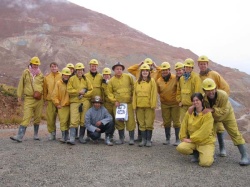 (Note: the historical info in this blog entry is written from memory of what the guide told us on the tour. I haven't had the chance to check all the facts, so please excuse inaccuracies (and kids, don't quote me for any school papers!) )
(Note: the historical info in this blog entry is written from memory of what the guide told us on the tour. I haven't had the chance to check all the facts, so please excuse inaccuracies (and kids, don't quote me for any school papers!) )We went on the Cooperative Mine Tour today. Potosi, charming town that it is, exists for and because of mining. The "Rich Mountain", Sumaj Orcko (Beautiful Mountain), rises behind the city, its triangular shape traced by lights at night.
First everyone was given pants and shirts to cover our clothing, hardhats, and rubber boots. Then we were driven to the "Miners' Market,"
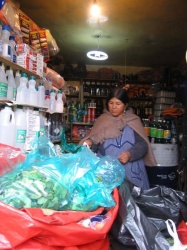
where we could buy gifts for any miners we met (tips for stopping and talking to us): coca leaves, cigarettes, 98% alcohol, drinks, dynamite and fuses.
It was pouring rain as the bus rocked up the muddy road to the mines. I had thought it was cool that the mines were run by a co-op but soon our guide enlightened us about the true situation. 20 years ago the mines had been state run. The miners had safety equipment, electricity in the mines, free schools for their children and other benefits. However, when it was determined the mines weren't making enough money, the state closed them. The miners insisted that they needed work and all they could do was be miners. The state responded that they could run the mines as cooperatives. However, the mines mostly became privately owned with the miners in the co-op paying the owner a monthly fee for the right to mine a claim. Then the miners sell what they find to smelters and refineries which are also owned by the mine owners. The miners must provide all their own equipment. They work in terrible conditions and most die around 50 from siliconitis of the lungs.
The guide showed us how to prepare dynamite and did a demonstration blast.
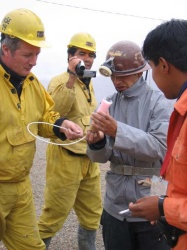
Explosion
Then we headed into the mines. They were cold and damp. Grey mud covered the ground and coated the rock walls. There were only a few miners working due to it being the weekend and the fiesta the night before.
We walked through the passages.
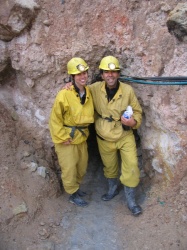
Occasionally our guide pointed out a vein of composite metals. The Spanish had extracted most of the pure silver so now the miners mined zinc, silver, lead, and tin which were found mixed together.
We also learned about the specifics of the work arrangement. To mine a claim, a miner must first start out as an assistant. Usually the assistant helps a relative: father, older brother, cousin. We saw one miner and his 14 year old assistant: his cousin.
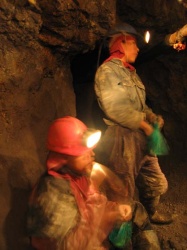
The assistant receives a set amount from the miner and only helps when the miner needs him (about 3 days a week). However, the assistant is not recognized as working (since it is against Bolivian child labor laws).
After working as an assistant, the man can ask the mine owner for a claim. The owner goes over the regulations and tells the miner where he can work, and where he must sell the ore he finds. The miner pays 500 Bolivianos per month to the owner. If he wants to use an electric drill he must pay 150 Bolivianos for 2 hours. Miners can make between 3000 to 5000 Bolivianos a month when the price of metal is good. Other months they make 1000 or less. From this they have to pay the owner and assistant as well as buy all their equipment. Due to this, (and perhaps culture) the miners don't wear masks to protect them from fumes. They also do most of the mining by hand using hammer and spike, and the same techniques used during the colonial times.
We saw a couple miners working. One was drilling a couple levels below.
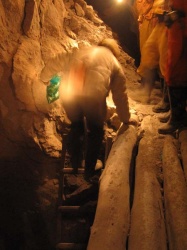
Deeper in the mine it is hotter and has more dangerous fumes but the miners who work there can make more money.
One part of the 2nd level of the mine had a small museum constructed by the miner.
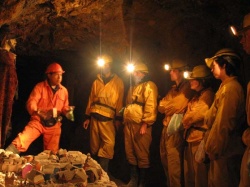
There were some manikins of people who were part of the mine's history: the Inca credited for discovering the mountain, Spanish, African slave workers (who died so quickly that the Spanish started using them to grow coca instead). The indigenous people were used in the mines to do most of the work. Huge numbers died working in conditions so severe and dangerous that the Spanish wouldn't even set foot inside the mines. They also worked in refineries using pools of mercury to process silver causing many to either go mad or die in frighteningly short times (2 weeks).
When the indigenous miners realized the Spanish wouldn't set foot in the mines, they started working less. The Spanish recognized the decrease in silver and invented a "Deus Malo" (bad god) and set a figure of this god in the mine. They told the indigenous people that this god would watch and kill them if they didn't work hard. The miners pronounced "Deus", Tio and the god of the mine was born. In the back of the museum was a large figure, sturdy and fierce. He had an open mouth which was stuffed with coca and at his feet were piles of empty alcohol bottles. The guide placed a lit cigarette in his mouth and showed how the miners anoint the figure with alcohol.
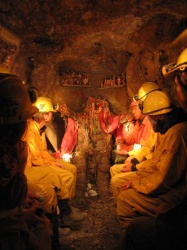
Now Tio has become an indigenous god. The miners offer him gifts so he will provide minerals and protect them. It is believed the union between Tio and the mountain (Pachamama/mother earth) produces minerals. Llama fetuses are buried in the ground so Pachamama will not bury the miners instead.
Women don't work in the mines. They say that since the mountain is a woman, having other women in the mine would displease her. The women do work outside of the mine separating the different minerals.
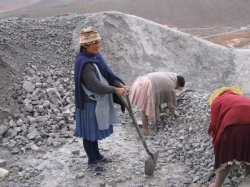
Back on the surface our guide told us how a previous president, (who now lives in Miami) owns a mine. The miners worked in terrible conditions and were going to start a revolution. There was a meeting and the president sent the army which killed all the leaders (25, I think). Later, the wives marched in protest with their babies on their backs an sticks of dynamite. They demanded, "Why did you kill our husbands and the fathers of our children." They said they couldn't survive without them. I don't know if any blew themselves up as they threatened but many were killed. Our guide sang us the song they sang, "Miners Volveramos." The former president's mines are closed now because aside from the human cost, he polluted the river which the communities relied on. The communities have chosen to keep the mines closed to preserve and recover the environment.
The whole mining history seems to be one tragedy after another. The current tragedy is how stuck the miners are in their life styles. It seems there is no way out. All the miners know how to do is mine using ancient methods. There are internationally owned mines with modern safety standards and equipment but they don't hire local miners because they aren't trained in the technology. Instead, the good paying work goes to miners from other countries. The locals are only able to get low paying jobs like watchmen for the mines.
But the miners need work so closing the mines would ruin their livelihood. There is too much distrust of the government for the miners to accept a state run option. So everyone seems stuck. And this is just thinking about the human side and not even considering the environmental costs.
Comments
- Comments
Powered by My Blog 1.69. Copyright 2003-2006 FuzzyMonkey.net.
Created by the scripting wizards at FuzzyMonkey.net..
(Code modified by Rowshan Dowlatabadi)
Created by the scripting wizards at FuzzyMonkey.net..
(Code modified by Rowshan Dowlatabadi)

